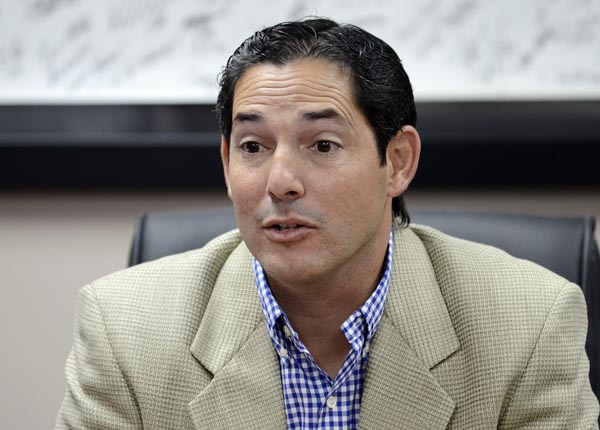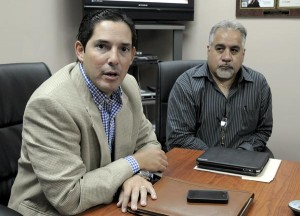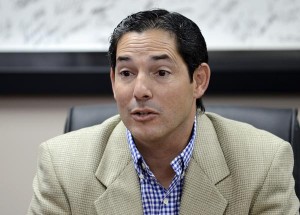Onelink makes hefty network investments to add services, capacity

Onelink Communications, the San Juan metropolitan area’s main cable television provider, will be investing some $26 million in network upgrades in 2012, on top of the $184 million it has pumped into its network in the last six years, company officials said Tuesday.
Jorge Hernández, vice president of Onelink, said Tuesday the hefty investments respond to the company’s ongoing bid to “provide and improve quality of services that make up our customer’s experience.”
During what can be described as a candid and open meeting with members of the media — something that had not occurred in quite some time — Hernández discussed Onelink’s current network improvements that call for eliminating analogue infrastructure in favor of all-digital facilities.
“This process of digitalization that we began earlier this year consists of improving the image and sound quality that we offer,” he said. “It is a two-part process that calls for technical and logistical strategies.”
On the technological side, scrambling the basic signal requires upgrading existing “head-end” facilities, which in the cable television realm is basically the heart of the operation. The task included reviewing all of the equipment needed to be able to deliver a crisp signal from that head-end to a client’s home, he said.
Late last year, Onelink asked the Federal Communications Commission for permission to scramble its analogue signal to be able to expand its services by freeing up space on its infrastructure, and also combat signal theft, which hovers at around 9 percent.
As far as logistics are concerned, Onelink’s conversion also required distributing mini-boxes, known as Digital Television Adapters, to the portion of its customer base — or about 85,000 homes — that currently receives its signal directly through the familiar coaxial cable. Subscribers will need a digital converter for every television set that is connected to cable, even if the set is “cable ready.”
“We asked the FCC for permission to encrypt the signal through the DTA’s as we do through our digital converter boxes,” said Néstor Cardona, executive director of technical services for Onelink. “That prevents us from having the problem of signal theft, because even if the DTA is stolen, if it’s not registered on the system, it won’t work.”
So far, the company has completed the service areas of Levittown and Bayamón, which account for 40,000 homes or 33 percent of Onelink’s customer base. The company has hired about 80 people to take on the task of going from home-to-home installing the equipment, Hernández said.
“We decided to deliver the equipment and complete the installation procedure ourselves, rather than sending the boxes through the mail, as many cable companies stateside have chosen to do,” Hernández said. “We want to make sure that the infrastructure inside the home is adequate and meets our installation and quality standards.”

Jorge Hernández, vice president and Néstor Cardona, executive director of technical services for Onelink. (Credit © Mauricio Pascual)
Choosing this route has made the conversion process more expensive for Onelink, which so far has invested $17 million in this project alone, a figure that is part of the $184 million invested since 2006, he said.
Next up are Guaynabo, Carolina, Trujillo Alto and San Juan, which will become digital in phases. The whole project should be completed by the second quarter of 2012, he said.
From that moment on, Onelink will begin rolling out new products that include new high-definition channels — with the goal of offering 100 by next year — and improved Internet capacity, Cardona said.
“Before the year is over, we should be adding eight new HD channels,” Cardona said, without disclosing which they would be.
Onelink’s customer base consists of 150,000 paid subscribers and 350,000 homes-passed, meaning that it has about 40 percent of its footprint covered.
IPTV controversy
During the roundtable, Onelink officials also addressed the controversy that has been swirling for the better part of the past three years related to Claro’s petition for a cable television franchise license to provide Internet-based paid television services throughout the island. If granted, Claro would compete head-on not only with Onelink, but also with the island’s other cable and satellite television providers.
The apparent dispute dates to 2008, when Claro first applied for a cable television franchise, a request Onelink objected to for several reasons.
“We’ve never suggested that Claro not be granted a franchise license. What we’ve said is that it should be evaluated carefully. Since the first time they applied, we detected problems with it, including crossed-subsidies and the fact that they wanted to force customers to have to buy a package of telephone and Internet services if they wanted television,” said Jorge Bauermeister, Onelink’s legal advisor.
Claro’s first petition for a franchise license submitted to the Telecommunications Regulatory Board in December 2008 was denied, spurring the carrier to re-submit a modified application a few weeks later. In that second round, Onelink wanted to participate in the evaluation, as it did in the first process, but was denied by the TRB.
The cable provider went on to appeal the board’s decision at the Appellate and Supreme Courts, which in December 2010 reverted the case back to the agency, saying Onelink could only participate after Claro was granted its franchise license.
The TRB has yet to decide on that matter, despite holding two public hearings so far this year, the last being two months ago.












So, when will we see an end to the 40 GB cap? Such a low cap was unheard of back in 2007, why do we even still have it in 2011?
If the cap is aimed at freeing up bandwidth for customers, why do I still see speeds drop to 0.5 Mbps every night? I’m on the 4 Mbps plan.
The HD channel offering from Onelink is laughable.
Why is Onelink charging $29.95 to install the small Digitall Television Adapter after notifying it would be free?
William Cuevas tel 787-287 0083
I don’t see any improvemente except in the price, $60 montly for only a low 4 mbit internet connection?. The most expensive internet connection in PR and in the USA. Normaly in the states you get at least 10 mbits for $40. “But remember, we are in Puerto Rico where the competition is to see who offers less and charges more”
I don’t see any improvemente except in the price, $60 montly for only a low 4 mbit internet connection?. The most expensive internet connection in PR and in the USA. Normaly in the states you get at least 10 mbits for $40. “But remember, we are in Puerto Rico where the competition is to see who offers less and charges more”
I am in Trujillo Alto and Jan 2011 I was told I would have new hd and faster Internet by may. One year late same sorry service that goes out more than satellite. They are scared of iptv because they would have to invest money. 65$ for 6mb is ridiculous. 50$ month for one DVR is more ridiculous. But what choice do you have if you live in an apartment? It’s a monopoly